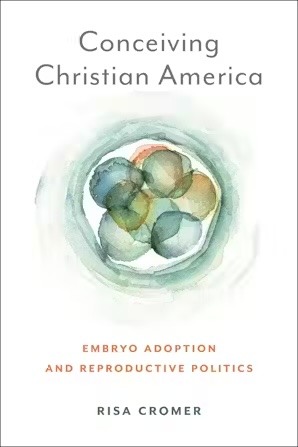Frozen Potential
A book review of Conceiving Christian America: Embryo Adoption and Reproductive Politics
- Journal article, Op-ed
Eliza Washington, RMSc
Research Coordinator, Metriarch
Disclosure: The author works for Metriarch, and this work includes one reference to a forthcoming Metriarch report.
Abstract
In vitro fertilization (IVF) has existed in the US since the early 80s. It’s a process through which conception can occur outside of a uterus, resulting in an embryo that can be implanted immediately or frozen for implantation later. In the US, IVF operates based on creating an excess of embryos to ensure successful implantation and pregnancy. Because of the excess this process creates, many more embryos are frozen than potential parents may need.
What happens to the unused embryos? In Conceiving Christian America, anthropologist Risa Cromer explores this question and delves into one particular path for frozen embryos: adoption.
By following the thread of embryo adoption through time and across the US, Cromer weaves a rich story about antiabortion politics, white saviorism, and family values which meld into the ideological foundations of the Christian right. Cromer has a perspective that is well worth our attention in the post-Dobbs era shift towards fetal personhood recognition.
I first learned of Cromer’s book Conceiving Christian America through a roundtable shared by the Anthropology and the Body Working group at the University of Amsterdam.
I joined the zoom call unsure of what to expect and found myself captivated by a conversation between anthropologists, medical historians, legal experts, and other scholars.
They discussed the complicated history of in vitro fertilization (IVF) leading to its then underregulated status in the United States (US). That history was woven into an engaging exploration of “Christian Right”1Cromer, Conceiving Christian America, 29. politics and fetal personhood.
As a reproductive justice advocate and an anthropologist working in public health within a politically conservative state, I was fascinated. I ordered the book soon after the call.
IVF has been around in the US since the early 1980s.2Thompson, “IVF Global Histories, USA,” 2016. It’s a process through which conception can occur outside of a uterus, resulting in an embryo which can be implanted immediately or frozen for implantation later with the hope of a resulting pregnancy.
In the US, the standard IVF process relies on creating an excess of embryos. Producing more embryos than clients may need increases the odds of successful fertilization and implantation.3Mayo Clinic, “In vitro fertilization,” n.d.
This excess also creates a challenge: what should be done with remaining embryos once clients consider their families to be complete? Cromer details a few options. IVF clients may choose to freeze embryos indefinitely, discard them as medical waste, donate them to scientific research, or donate them to other IVF clients via “embryo adoption.”
According to Cromer, the embryo adoption pipeline in the US is a manufactured political and rhetorical tool of the “white evangelical right.”4Cromer, Conceiving Christian America, 3-6; 9-10. By constructing5That is to say, crafting and sharing a description of embryos to match a belief system. embryos as innocent symbols worthy of saving (i.e. worthy of “futures with white heterosexually married Christian couples”), evangelicals are able to situate themselves as saviors.6Cromer, Conceiving Christian America, 28. The author argues that within this construction, the salvation of embryos through adoption and family values acts as a mirror of the salvation of the nation through Christian moral order.
Indeed, the very term “family values” wields substantial power within US politics. The term has rhetorical significance, grouping issues such as gender, sexuality, race, gun control, immigration, reproduction, and economics.7Cromer, 28. It is used to argue against desegregation, feminism, and abortion. To Cromer, abortion has become a major symbol of the threat to family values and therefore to national Christian moral order.8Cromer, 22-24.
To address this threat, voices within the Christian right turn to innocence politics and fetal personhood. Through this position they label embryos and fetuses as innocent lives worthy of saving. To create an image of savable innocence (marked by purity, vulnerability and political neutrality) one must also be able to imagine the savior (marked by moralism and piety).9Cromer, 26. The hidden members of this trichotomy are the un-savable.
As Cromer reveals, personhood is and always has been political, and who is savable has always been racialized.10Racialization referring to the “process through which something comes to bear racial meaning through markings of difference.” Cromer, 27. When the US was formed legislation gave rights and personhood status only to white landowning men, “illustrating the intersections of gender and class in racist constructs of personhood.”11Cromer, 13. She also notes the ongoing disparities in preterm birth and infant mortality within Black populations in the US, and lack of systemic intervention to address this issue, as an example of current difficulties with savability in practice.12Cromer, 27.
Although Cromer speaks often of social stratification and its impact on embryo politics, I would have appreciated additional reference to anthropologist Shellee Colen’s concept of stratified reproduction.13Colen, “’Like a Mother to Them,'” 295. Stratified reproduction is a framework for understanding how some people are enabled and supported in reproductive endeavors while others have their reproductive journeys restricted or interfered with. Both economic and racial elements of stratified reproduction seem to play into the narrative Cromer creates.
The legislative and criminal implications of Cromer’s research are exemplified in recent attacks on IVF and assisted reproductive technologies (ART). Alabama’s Supreme Court (SC) has made national headlines for its recent decisions on fetal personhood.14Baker et al., “Alabama governor signs IVF bill,” 2024. In February 2024 the Alabama SC declared that all unborn fetuses, including embryos, were considered children and deserving of the full rights of children, in the eyes of the state law.15Gunther, “Alabama Supreme Court Rules In-Vitro Embryos are Children,” 2024. The case was the result of a 2021 incident in which embryos of an IVF couple were destroyed by an intruder at the clinic where they were being stored.16Gunther, 2024. The SC decision gave the IVF couple which owned the embryos the right to pursue damages against the clinic under Alabama’s Wrongful Death of a Minor Act.17Chung, “US Supreme Court rejects IVF clinic’s appeal of Alabama embryo ruling,” 2024.
This had a freezing effect on ART provision in the state, as the commonplace practice of discarding unviable embryos became a criminal act akin to homicide overnight. Soon afterward an exception was made to provide immunity to IVF providers and clients.18Baker et al., 2024. Although the IVF-related trial opened the door to legal fetal-personhood, it’s clear that IVF providers themselves are not the only target of the Alabama SC decision, and indeed are now protected from it at least for now.19Pregnancy Justice, “The Legal Assault on Pregnant People’s Personhood,” 2024.20Ollstein and Leonard, “Republicans Block Democratic Bill on IVF Protections,” 2024. Instead, the harmful consequences of legally enshrined fetal personhood lie with Alabamans who are able to carry a pregnancy. As Cromer says, when “lawmakers [ascribe] social, legal, and medical status to fertilized eggs, embryos, and fetuses as rights-bearing subjects, they actively [erode] the reproductive freedoms of those who bear them.”21Cromer, 18.
Alabama leads the nation in pregnancy related criminalization.22Pregnancy Justice, “The Legal Assault on Pregnant People’s Personhood,” 2024. Oklahoma is second, with 68 cases from June 24, 2022 to June 23, 2023 alone.23Pregnancy Justice. “Pregnancy As a Crime,” 2024. Most of the state’s cases have been tied to prenatal substance exposure, leading to felony child abuse cases.24Pregnancy Justice, “Pregnancy As a Crime,” 2024.25Metriarch, Paths to Recovery, forthcoming. As other states follow in their lead and continue the push for fetal personhood, we enter a crisis of reproductive justice violations. Access to reproductive services also becomes further stratified geographically and economically as people struggle to access ART or abortion services within their area or even within surrounding states. We cannot turn a blind eye and must be wary of the slow creep of reproductive rights infringements. Cromer states profoundly in her closing arguments that “wariness is a necessary companion” to imagining another path.
About the authors

Eliza Washington, RMSc
Research Coordinator, Metriarch
Eliza is an anthropologist with extensive training in qualitative and mixed methods research. Their work is centered around reproductive justice and addressing social/structural disparities that impact healthcare access. In their role as Research Coordinator with Metriarch, Eliza utilizes the full data life cycle to center marginalized voices and address equity gaps in healthcare and policy.
Bibliography
Baker, Liz, Debbie Elliott, and Susanna Capelouto. “Alabama Governor Signs IVF Bill Giving Immunity to Patients and Providers.” NPR. March 6, 2024. https://www.npr.org/2024/03/06/1235907160/alabama-lawmakers-pass-ivf-immunity-legislation;
Chung, Andrew. “US Supreme Court Rejects IVF Clinic’s Appeal of Alabama Embryo Ruling.” Reuters. October 7, 2024. https://www.reuters.com/legal/us-supreme-court-rejects-ivf-clinics-appeal-alabama-embryo-ruling-2024-10-07/.
Colen, Shellee. “‘Like a Mother to Them’: Stratified Reproduction and West Indian Childcare Workers and Employers in New York.” In Feminist Anthropology: A Reader, edited by Ellen Lewin, 380. Malden, MA: Wiley-Blackwell, 2006.
Cromer, Risa. Conceiving Christian America: Embryo Adoption and Reproductive Politics. New York: New York University Press, 2023.
Gunther, Brad. “Alabama Supreme court rules in-vitro embryos are children.” NBC News 15. February 16, 2024. https://mynbc15.com/amp/news/local/alabama-supreme-court-rules-in-vitro-embryos-are-children
Lewin, Ellen, ed. Feminist Anthropology: A Reader. Malden, MA: Wiley-Blackwell, 2006.
Mayo Clinic. “In vitro fertilization (IVF).” Mayo Clinic. n.d. https://www.mayoclinic.org/tests-procedures/in-vitro-fertilization/about/pac-20384716
Metriarch. “Paths to Recovery: A mixed-methods report on pregnancy and substance use in Oklahoma.” Forthcoming.
Ollstein, Alice Miranda, and Ben Leonard. “Republicans Block Democratic Bill on IVF Protections.” POLITICO. September 17, 2024. https://www.politico.com/news/2024/09/17/republicans-block-ivf-bill-00179626.
Pregnancy Justice. “Pregnancy As a Crime: A Preliminary Report on the First Year After Dobbs.” 2024. https://www.pregnancyjusticeus.org/wp-content/uploads/2024/09/Pregnancy-as-a-Crime.pdf.
Pregnancy Justice. “The Rise of Pregnancy Criminalization.” 2023. https://www.pregnancyjusticeus.org/wp-content/uploads/2023/09/9-2023-Criminalization-report.pdf.
Pregnancy Justice. “Unpacking Fetal Personhood: The Radical Tool That Undermines Reproductive Justice.” 2024. https://www.pregnancyjusticeus.org/wp-content/uploads/2024/09/Fetal-personhood.pdf.
Thompson, Charis. “IVF Global Histories, USA: Between Rock and a Marketplace.” Reproductive Biomedicine & Society Online 2 (June 1, 2016): 128–35. https://doi.org/10.1016/j.rbms.2016.09.003.
Share this page:
More from Metrilineal

Bleeding Behind Bars: Access (and lack thereof) to Menstrual Products in Prisons
Bleeding Behind Bars Access (and lack thereof) to Menstrual Products in Prisons Read More

Scolded at the vasectomy pre-op: Family planning is a heavily gendered responsibility, and that doesn’t make sense
Scolded at the vasectomy pre-op Family planning is a heavily gendered responsibility, Read More

Government Mandated Parental Leave in Oklahoma: Addressing Structural Racism
Government Mandated Parental Leave in Oklahoma Addressing Structural Racism Abstract In 2023, Read More


